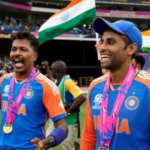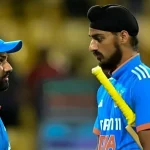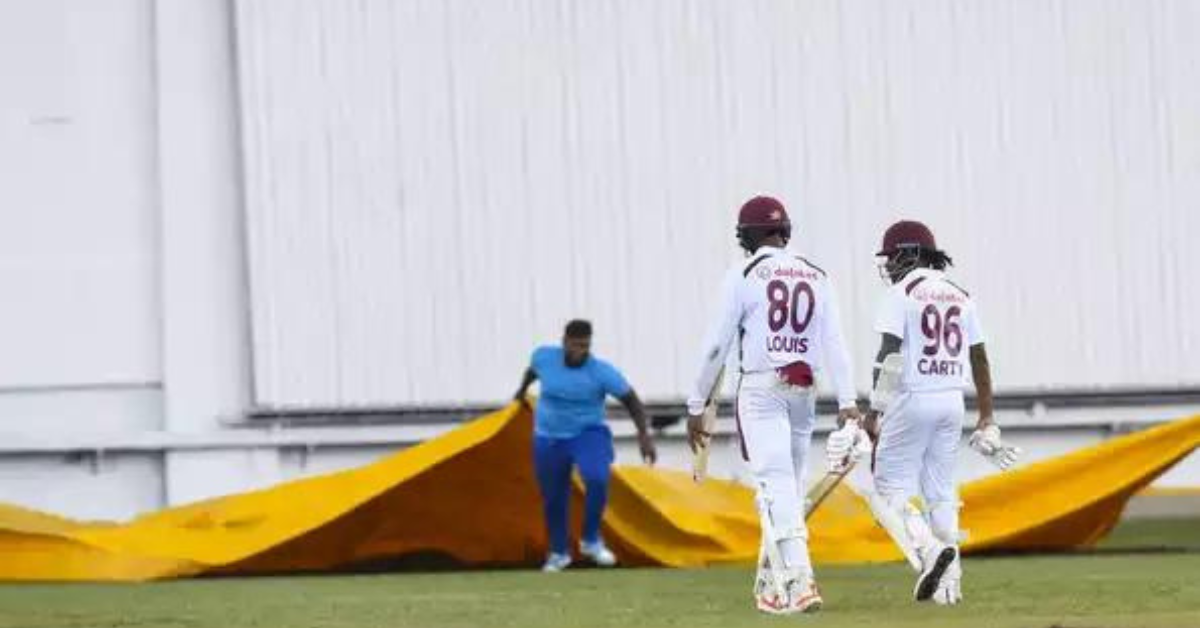Cricket has often been celebrated for its unpredictable nature, but the Trinidad Test between South Africa and the West Indies was a match defined not by its twists and turns, but by the frustrating predictability of the rain-soaked and lifeless pitch at Queen’s Park Oval. In what could have been a riveting contest, the game instead limped towards an inevitable and disappointing conclusion. As we reflect on the events that transpired, it becomes clear that this match was less about the competition between bat and ball and more about the unfortunate circumstances that rendered it irrelevant. Here’s a closer look at the match that should have been a thrilling encounter but turned into a sobering reminder of Test cricket’s vulnerabilities.
Stubbs’ Spark: A Brief Flicker in a Gloomy Contest
The Trinidad Test may have been marred by lifeless cricket, but Tristan Stubbs’ innings provided a rare spark. In the 28th over of South Africa’s second innings, Stubbs offered a glimpse of the potential excitement this match could have delivered under different conditions. First, he reached his maiden half-century, a milestone he achieved with a powerful stroke to deep midwicket. The following delivery saw Stubbs switch to a left-handed stance, a bold move that resulted in a four over backward point, showcasing his innovative approach.
However, his flamboyant display was cut short by Kemar Roach, whose delivery stayed low and uprooted Stubbs’ leg stump. Stubbs’ innings, which ended at 50 runs off 42 balls, was a bustling, energetic performance that stood in stark contrast to the overall dullness of the match. His aggressive play underscored South Africa’s intention to inject some urgency into the game, a task they took upon themselves as they tried to stay ahead of the rain that had become their biggest adversary.
Brathwaite’s Tactical Gamble: Time vs. Wickets
Kraigg Brathwaite’s decision to review an LBW call against Stubbs wasn’t just a strategic move—it was a clear indication of the dire circumstances surrounding the match. With South Africa leading by 282 runs, Brathwaite knew that taking wickets was less about chasing victory and more about buying time as rain loomed ominously on the horizon. His appeal to the third umpire wasn’t about overturning the decision but about delaying the inevitable in hopes that the weather would intervene.
This moment exemplified the desperation felt by both teams as they grappled with the reality of playing on a pitch that was doing little to facilitate an exciting contest. The situation was exacerbated by the fact that South Africa’s lead was already significant, and the West Indies had little chance of chasing it down. The match had become more about the clock and the clouds than about the cricket itself, a sad state of affairs for what should have been a gripping Test match.
Bavuma’s Bold Declaration: Racing Against the Rain
South Africa’s captain, Temba Bavuma, was acutely aware of the limited time left in the match and the imminent threat of rain. His decision to declare the innings closed after Stubbs’ dismissal was a calculated risk. The West Indies were set a target of 298, a formidable challenge on a deteriorating pitch and under overcast skies. Bavuma’s decision to not even change his shirt between innings—returning to the field with sweat still visible—was a testament to his urgency to keep the game moving.
Bavuma’s declaration was a bold move, designed to give his bowlers enough time to take ten wickets while staying ahead of the weather. It was a clear signal that South Africa were playing to win, despite the increasingly unfavorable conditions. The intensity of Bavuma’s approach was mirrored by his bowlers, particularly Keshav Maharaj, who immediately made an impact with the new ball.
Maharaj’s Magic: A Brief Glimmer of Hope
Keshav Maharaj, who had already bowled tirelessly in the first innings, was entrusted with the new ball in the second innings. His third delivery turned appreciably, catching the edge of Kraigg Brathwaite’s bat and flying into the covers, where Tristan Stubbs completed the catch. This early breakthrough provided a fleeting moment of excitement for the South Africans, as it seemed that Maharaj might just be able to spin his team to victory.
Maharaj’s dismissal of Brathwaite was significant, as it removed the West Indies’ most experienced batsman early in the innings. Brathwaite’s rash shot was uncharacteristic, perhaps reflecting the pressure of the situation and the growing frustration with the conditions. Unfortunately, despite Maharaj’s best efforts, the rain soon returned, and the match began to slip away as a contest.
Rabada’s Resilience: Battling Against the Elements
Kagiso Rabada, South Africa’s pace spearhead, continued to toil hard, despite the challenging conditions. He nearly dismissed Keacy Carty twice in quick succession—first with an edge that almost rolled onto the stumps, and then with an LBW appeal that was only denied by the umpire’s call. Rabada’s persistence was commendable, as he refused to let the lifeless pitch and the looming rain dampen his determination.
Rabada’s efforts were eventually rewarded when he induced a mistimed shot from Mikyle Louis, resulting in a straightforward catch at midwicket. However, these moments of success were overshadowed by the frequent interruptions caused by rain. The stop-start nature of the match made it difficult for South Africa to build momentum, and the game began to drag on with little to offer in terms of competitive cricket.
Athanaze’s Unheralded Effort: A Lone Warrior in a Lost Cause
While much of the attention was on South Africa’s attempts to force a result, Alick Athanaze quietly went about compiling his highest Test score of 92. His innings was a study in patience and concentration, as he held the West Indies innings together while wickets fell around him. Athanaze’s effort was impressive, but it ultimately became a footnote in a match that was defined by its lack of meaningful action.
Athanaze’s batting was a reminder that even in the most uninspiring of matches, individual performances can still shine through. However, the broader context of the match—dominated by rain delays and a dead pitch—meant that his knock would likely be forgotten in the grand scheme of things. It was a shame that such a composed and technically sound innings didn’t have a greater impact on the outcome of the game.
A Disgrace to the Game: The Problem with Pitches and the ICC’s Role
The Trinidad Test will be remembered not for its cricketing moments, but for the conditions that rendered it a farce. The pitch at Queen’s Park Oval was unacceptable for Test cricket—too lifeless to provide a fair contest between bat and ball. The rain, which is always a risk in Caribbean Tests, compounded the issue, but it was the pitch that ultimately killed the match as a spectacle.
The ICC must take responsibility for allowing such pitches to be used in the premier format of the game. Test cricket is already facing challenges in terms of maintaining its relevance in a world increasingly dominated by shorter formats. Matches like this one do nothing to help its cause. The pitch at Trinidad should be kept as a stark reminder of what not to do if Test cricket is to survive and thrive in the modern era.
A Test Match Lost to the Elements and Indifference
In the end, the Trinidad Test was a match that was not drawn, but killed—killed by the weather, by a dead pitch, and by the lack of meaningful action. What could have been a thrilling contest between two competitive teams instead became a dull, dreary affair that did a disservice to the sport. The brief moments of excitement, provided by players like Tristan Stubbs, Keshav Maharaj, and Alick Athanaze, were not enough to save the match from its inevitable slide into irrelevance.
This Test match should serve as a wake-up call for those in charge of the game. Test cricket deserves better than this. It deserves pitches that offer a fair contest, and it deserves a commitment from all involved to ensure that it remains the pinnacle of the sport. The Trinidad Test will be quickly forgotten, but the lessons it offers must not be ignored.
Please check for information on the best betting sites in India – https://selectory.org/best-betting-sites/
Related posts:
 Sunil Narine opens up on his T20 World Cup return after performing exceptionally well in IPL 2024
Sunil Narine opens up on his T20 World Cup return after performing exceptionally well in IPL 2024
 Liverpool’s Premier League title hopes hit by 2-0 loss to Everton, Man United survive another scare
Liverpool’s Premier League title hopes hit by 2-0 loss to Everton, Man United survive another scare
 NBA playoffs: Thunder roll past Mavericks in Game 1 as youth prevails again
NBA playoffs: Thunder roll past Mavericks in Game 1 as youth prevails again
 IPL 2024, GT vs CSK: Narendra Modi Stadium Pitch Report, Ahmedabad Weather Forecast, T20 Stats & Records | Gujarat Titans vs Chennai Super Kings
IPL 2024, GT vs CSK: Narendra Modi Stadium Pitch Report, Ahmedabad Weather Forecast, T20 Stats & Records | Gujarat Titans vs Chennai Super Kings
 IPL: Kochi Tuskers Kerala didn’t pay money to cricketers, reveals former India pacer S. Sreesanth
IPL: Kochi Tuskers Kerala didn’t pay money to cricketers, reveals former India pacer S. Sreesanth
 Colombia lost Copa América final but won back a nation’s hearts
Colombia lost Copa América final but won back a nation’s hearts
 Suryakumar Yadav’s latest Instagram story sparks speculation amid T20I captaincy rumours
Suryakumar Yadav’s latest Instagram story sparks speculation amid T20I captaincy rumours
 Indian players trust Suryakumar Yadav more than Hardik Pandya, BCCI got feedback. MI dressing room chaos added fuel
Indian players trust Suryakumar Yadav more than Hardik Pandya, BCCI got feedback. MI dressing room chaos added fuel
 Olympics 2024: Why football, archery and rugby have started in build-up to opening ceremony in Paris
Olympics 2024: Why football, archery and rugby have started in build-up to opening ceremony in Paris
 Lewis Hamilton wins Belgian Grand Prix after George Russell DQ
Lewis Hamilton wins Belgian Grand Prix after George Russell DQ
 India vs Sri Lanka Live Streaming 1st ODI Live Telecast: When And Where To Watch Match Live
India vs Sri Lanka Live Streaming 1st ODI Live Telecast: When And Where To Watch Match Live
 Rohit Sharma ‘disappointed’ as Team India fails to score 1 run from 14 balls in 1st ODI against Sri Lanka
Rohit Sharma ‘disappointed’ as Team India fails to score 1 run from 14 balls in 1st ODI against Sri Lanka
 Kyle Mayers hits an unbelievable no-look six in the Global T20 Canada 2024
Kyle Mayers hits an unbelievable no-look six in the Global T20 Canada 2024
 WEF-W vs NOS-W, The Hundred Women’s 2024: Match Prediction, Dream11 Team, Fantasy Tips & Pitch Report | Welsh Fire vs Northern Superchargers
WEF-W vs NOS-W, The Hundred Women’s 2024: Match Prediction, Dream11 Team, Fantasy Tips & Pitch Report | Welsh Fire vs Northern Superchargers
 Photos: Jitesh Sharma gets engaged to Shalaka Makeshwar; Suryakumar Yadav and other cricketers offer congratulations
Photos: Jitesh Sharma gets engaged to Shalaka Makeshwar; Suryakumar Yadav and other cricketers offer congratulations
